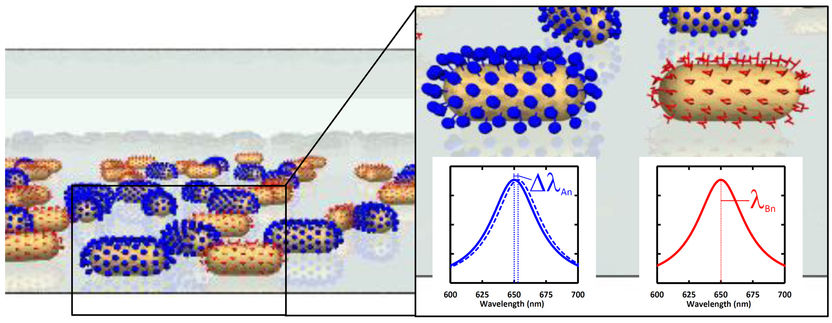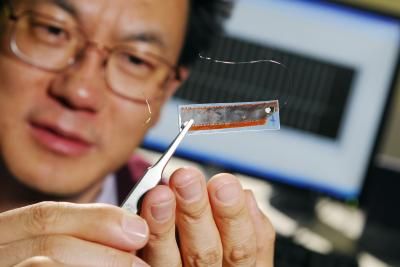Chemists develop innovative nano-sensors for multiple proteins
Test strips bearing gold nano-particles as sensor elements can detect numerous proteins simultaneously
Advertisement
Chemists at Johannes Gutenberg University Mainz (JGU) have developed a new method for parallel protein analysis that is, in principle, capable of identifying hundreds or even thousands of different proteins. It could be used to detect the presence of viruses and identify their type in tiny samples. At the same time, it is very cost-effective and quick. "We see possible applications of this technique in medicine, where it could be used, for example, for the rapid diagnosis of a wide range of diseases. It would be almost as easy to use as a pregnancy test strip," said Professor Carsten Sönnichsen of the Institute of Physical Chemistry. The test involves placing a tiny drop of blood, saliva, or other bodily fluid on a small test strip, which is then placed in a device developed at the JGU Institute of Physical Chemistry. This device is able to identify the specific proteins in the fluid and thus allows to quickly and reliably differentiate between harmless microorganisms and dangerous pathogens.

When proteins dock with the specifically functionalized nano-particles, the sensor elements change color.
Institute of Physical Chemistry, JGU
In order to detect the many different substances present in a small sample, the sensors need to be as tiny as possible, preferably the size of nano-particles. Sönnichsen's team of scientists have designed a sensor no larger than the head of a pin but capable of performing a hundred different individual tests on a surface that is only of one-tenth of a square millimeter in area. The 'test strips' consist of glass capillary tubes that have gold nano-particles as sensor elements on their internal surfaces. "We first prepare our nano-particles using short DNA strands, each of which binds to a specific type of protein," explained Janak Prasad, who developed the functionalization method. When a protein docks with one of these special DNA strands, called aptamers, the corresponding nano-particle changes its color. The color changes can be detected with the aid of a spectrometer. For this purpose, the capillary tubes are placed under a microscope designed, constructed, and provided with the necessary software by the Mainz-based team of chemists.
"We demonstrate a new approach for a multiplexed assay that detects multiple proteins simultaneously by letting a fluid flow past the randomly positioned gold nano-rods," explained Christina Rosman, first author of the study. The team from JGU's Institute of Physical Chemistry used four different target proteins to demonstrate the viability of the new concept, its ability to detect concentrations in the nanomolar range, and the possibility to recycle the sensors for more than one analysis. "We see the potential to extend our method to the simultaneous detection of hundreds or even thousands of different target substances," assert the authors in their article published in the June 2013 issue of the journal Nano Letters. Low-cost serial production of the sensors is feasible if advanced nano-fabrication methods such as nano-printing or optical trapping are used.
There are manifold possible applications of a test for multiple targets in a single procedure. The low-cost sensors could be directly used by physicians in their practices in order to detect and discriminate various types of flu viruses with which their patients could be infected. In addition, the technique would also be suitable for detecting the presence of toxins in the environment or in food, particularly in liquids such as milk or baby food, or the presence of doping or other illicit drugs.
Original publication
Other news from the department science
These products might interest you
Most read news
More news from our other portals
See the theme worlds for related content
Topic world Sensor technology
Sensor technology has revolutionized the chemical industry by providing accurate, timely and reliable data across a wide range of processes. From monitoring critical parameters in production lines to early detection of potential malfunctions or hazards, sensors are the silent sentinels that ensure quality, efficiency and safety.

Topic world Sensor technology
Sensor technology has revolutionized the chemical industry by providing accurate, timely and reliable data across a wide range of processes. From monitoring critical parameters in production lines to early detection of potential malfunctions or hazards, sensors are the silent sentinels that ensure quality, efficiency and safety.



































































